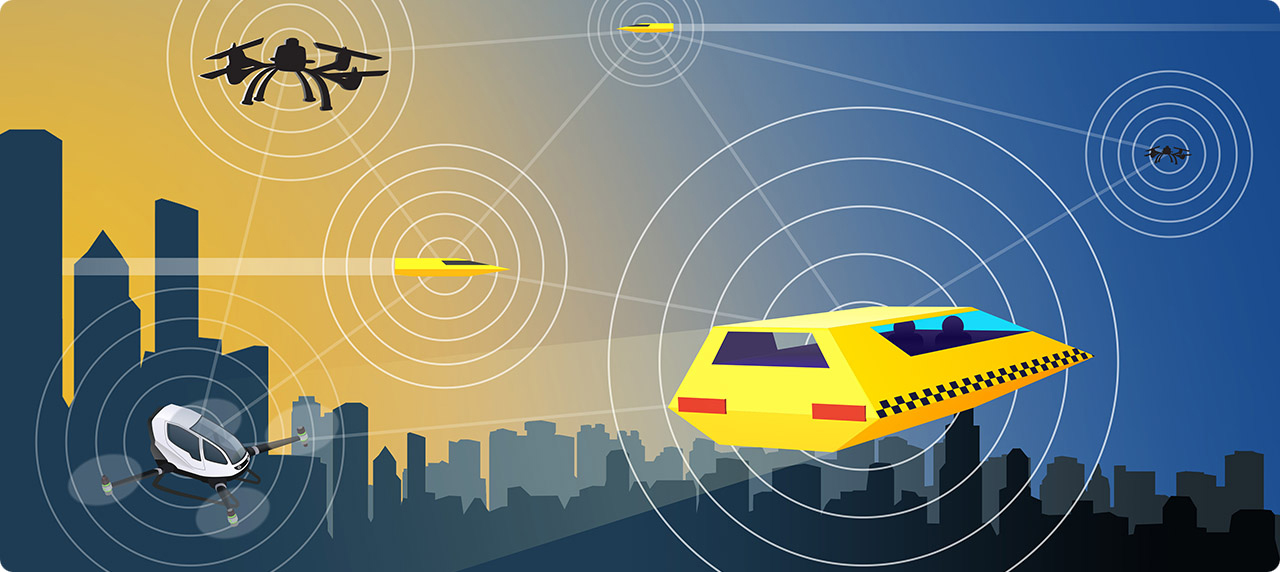News
The Future of Uncrewed Aerial Systems Depends on Public Trust
While technological advances will play a central role in enabling uncrewed aircraft systems (UASs) in commercial applications, the successful implementation of these systems will depend more on public confidence than on any technical achievement, noted Charlie Leeper, the lead engineer for the international Airborne Collision Avoidance System X, or ACAS X.
Leeper made his comments as part of a panel discussion about the future of airspace safety, held at the Johns Hopkins Applied Physics Laboratory (APL) in Laurel, Maryland.
“It’s one thing to technically enable a future where drones are making deliveries in a sky full of uncrewed air taxis, but it’s another thing to decide that we really want that,” said Leeper, an electrical engineer in APL’s Asymmetric Operations Sector. “Public acceptance and trust of artificial intelligence and autonomy is the truly hard problem, and it’s one that will be ultimately decided by society, not by engineers or regulators.”
The discussion was part of an event celebrating APL’s work on ACAS X. It included several key members of the team, including Leeper, Josh Silbermann, Walter Bender, Sam Smearcheck and Ben Zintak. Together with partners at the Federal Aviation Administration (FAA), the Massachusetts Institute of Technology Lincoln Laboratory, the MITRE Corporation and other leading organizations in the field, APL’s ACAS X team developed a forward-fit system that will gradually replace the current ACAS system on all large passenger aircraft worldwide.
ACAS X: Forward-Thinking Collision Avoidance
Air travel is one of the safest forms of transportation that has ever existed, thanks in large part to modern collision avoidance systems found onboard nearly all commercial jets. However, as more and more UASs are introduced to the airspace — bringing with them a mind-boggling range of vehicles, altitudes and missions — the challenge of managing air traffic will increase exponentially.
ACAS X detects nearby aircraft by receiving sensor measurements from onboard surveillance systems and estimates the relative position and speed of these aircraft by using tracking algorithms. The system then weighs the costs of all actions the pilot could take and decides on a single best action. If a collision avoidance alert is necessary, ACAS X sends this information directly to the pilot via the flight deck displays.
ACAS Xa introduces additional surveillance data and optimized resolution advisories, improving on the current system without changing the cockpit interface, using the same alerts and presentation. This new system was officially published as a new international standard in 2018, after successfully logging hundreds of millions of simulated encounters and passing rigorous operational evaluations by professional pilots. It will replace legacy systems as they are retired.
“Within the next couple years, the FAA predicts there will be millions of commercial and recreational drones flying in the National Airspace System,” said Silbermann, APL’s ACAS X project manager. “That represents a huge opportunity to enable routine autonomous operations such as search and rescue, precision agriculture and medical delivery, but it also brings challenges. Thanks to the incredible work from our teams, we’re one step closer to ensuring the safe integration of uncrewed platforms into an airspace traditionally used by piloted aircraft.”
The incorporation of UAS safety into the National Airspace System extends to a family of existing and developing systems, including the ACAS Xu, a detect-and-avoid system developed for large uncrewed aircraft; the ACAS sXu, a system designed specifically for small UASs, which won a 2022 R&D 100 Award; and the ACAS Xr, currently in development for rotorcraft, including uncrewed air taxis.
Low-Altitude Airspace — Great Opportunities, Critical Questions
Silbermann said that some of the most promising opportunities presented by UASs are in low-altitude applications — missions such as medical deliveries, critical infrastructure inspection, and search and rescue. However, he added, the low-altitude airspace also presents some of the most difficult technical problems that remain to be solved.
“A lot of the work in this area is in expanding the scope beyond just detect-and-avoid, and trying to really understand how the whole low-altitude picture looks when you combine small uncrewed craft interacting with traditional aircraft that have people onboard,” Silbermann said. “That’s a very hard problem that we’re working on. There are some phenomenal opportunities in the low-altitude airspace, but some tremendous challenges as well.”
